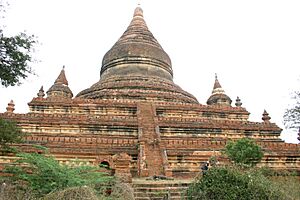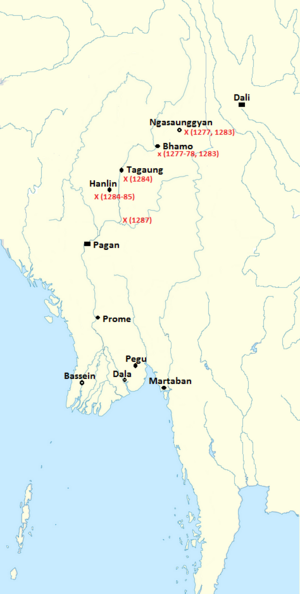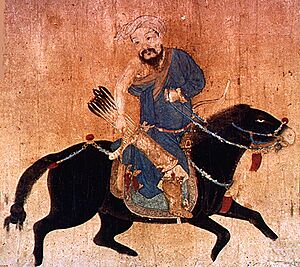Narathihapate facts for kids
Quick facts for kids Narathihapateနရသီဟပတေ့ Sithu IV of Pagan |
|||||
|---|---|---|---|---|---|
| King of Burma | |||||
| Reign | 6 May 1256 – 1 July 1287 | ||||
| Coronation | November 1256 | ||||
| Predecessor | Uzana | ||||
| Successor | Kyawswa | ||||
| Chief Minister | Yazathingyan (1256–57, 1258–60) Ananda Pyissi (c. 1271–87) |
||||
| Born | 23 April 1238 Friday, 9th waxing of Kason 600 ME Pagan (Bagan) |
||||
| Died | 1 July 1287 (aged 49) Tuesday, 5th waning of Waso 649 ME Prome (Pyay) |
||||
| Consort | Yadanabon (1256–62) Saw Hla Wun Saw Nan Shin Hpa Shin Mauk Shin Shwe Saw Lon |
||||
| Issue | Yazathu Uzana Pwa Saw Shin Thihathu Kyawswa Mi Saw U Sithu |
||||
|
|||||
| House | Pagan | ||||
| Father | Uzana | ||||
| Mother | Su Le Htone | ||||
| Religion | Theravada Buddhism | ||||
Narathihapate (Burmese: နရသီဟပတေ့; 23 April 1238 – 1 July 1287) was the last king of the Pagan Empire. He ruled from 1256 to 1287. People in Burmese history remember him as "Taruk-Pyay Min." This means "the King who fled from the Taruks (Mongols)." He got this name because he ran away from Pagan in 1285. This happened during the first Mongol invasion.
In January 1287, he agreed to be under the rule of Kublai Khan. Kublai Khan was the leader of the Yuan dynasty. In return, the Mongols left northern Burma. But six months later, his son Thihathu killed him. After Narathihapate's death, the 250-year-old Pagan Empire broke into many smaller states. This period of many small kingdoms in the Irrawaddy valley lasted for about 250 more years.
Old royal records, called chronicles, do not speak kindly of him. They say he was a scared king who ran from invaders. They also called him "an ogre" and "glutton." These records describe him as very angry, proud, and greedy. However, historians today believe he was not a good ruler. But they also think the chronicles unfairly blamed him for the empire's fall. The empire was already getting weaker before he became king.
Contents
Early Life of Narathihapate
Narathihapate was born on April 23, 1238. His father was Crown Prince Uzana. His mother was a commoner from Myittha. For many years, people at the palace called him Min Khwe-Chi. This nickname meant "Prince Dog's Dung," suggesting he was seen as harmless. Even when his father became king in 1251, he was not expected to be the next ruler. His older half-brother, Thihathu, was supposed to take the throne.
Becoming King
Things changed suddenly. In May 1256, King Uzana died in a hunting accident. His half-brother Thihathu tried to become king. But the court, led by a powerful minister named Yazathingyan, did not want Thihathu. They chose Khwe Chi instead, thinking they could control him.
Khwe Chi became king on May 6, 1256. Thihathu was arrested and killed. In November 1256, Narathihapate had his official crowning ceremony. He took the royal name "Śrī Tribhuvanādityapavara Dhammarāja."
How He Ruled
The young king quickly showed he was quick-tempered, proud, and harsh. Soon after becoming king, he sent Yazathingyan, the man who helped him get the throne, away from the court. But he soon had to call Yazathingyan back. This was because rebellions started in Martaban (1258–1259) and Arakan (1258–1260).
Yazathingyan stopped these rebellions. But he died on his way back. With his death, there was no one left to control the king. Narathihapate was not good at managing his country or dealing with other nations. The royal treasury, which held the kingdom's money, was running low. This was because more and more land was given to religious groups, and this land did not have to pay taxes.
Unlike his grandfather Kyaswa, who built small temples, Narathihapate built a very grand temple. This was the Mingalazedi Pagoda. He made people work on it without pay. The people were suffering under his rule. They secretly said, "When the pagoda is finished, the king shall die."
Mongol Invasions
A big threat to the Burmese kingdom came from the north. The Mongols had conquered the Dali Kingdom (now Yunnan) between 1253 and 1257. In 1271–72, they first demanded that Pagan pay them tribute. This meant Pagan would have to send gifts and show they were under Mongol rule.
The Burmese king refused. So, Emperor Kublai Khan sent another message in 1273, asking for tribute again. The king refused once more.
Border Conflicts (1277–78)
In 1275–76, the Mongol army of the Yuan dynasty took control of the border areas between Pagan and Yunnan. They did this to stop people from the Song dynasty from escaping. During this time, they also took over a small state that was under Pagan's rule. This area is now in Dehong Prefecture.
Narathihapate sent his army to get the region back. But his army was defeated in April 1277. This happened at the battle of Ngasaunggyan. Mongol troops went as far south as Kaungsin. This place guarded the Bhamo Pass, which was a way into the Irrawaddy valley. But the Mongols left in 1278 because of the extreme heat. Later in 1278, the Burmese army rebuilt their forts at Kaungsin and Ngasaunggyan.
Full Invasion (1283–85)
Narathihapate's problems continued. In 1281, the Mongol emperor again demanded tribute. When the king refused, the emperor ordered a full invasion of northern Burma. In September 1283, Mongol forces attacked the Burmese fort at Ngasaunggyan. It fell on December 3, 1283. Kaungsin fell six days later. The Mongols then took Tagaung on February 5, 1284.
However, the Mongols found the heat too much and left Tagaung. The Burmese forces took Tagaung back on May 10, 1284. The Mongols started moving south again in the next dry season (1284–85). By February 1285, they reached Hanlin. Even though the Mongols were not ordered to attack Pagan, the king still fled south to Lower Burma.
Life in Exile (1285–87)
In Lower Burma, Narathihapate felt alone. His three sons controlled three important ports: Bassein, Dala, and Prome. But he could not get their help. He did not trust them anyway. He settled in Hlegya, west of Prome. This place was on the border between Central and Lower Burma.
The king and his small army did not impress anyone. Pegu revolted soon after. They pushed back the king's small army twice. With Martaban also rebelling, Pegu breaking away meant the whole eastern part of Lower Burma was now in revolt. His three sons still controlled the western part of Lower Burma, but he could not rely on them. At Hlegya, the king was almost at the edge of Lower Burma.
Becoming a Mongol Vassal (1287)
He decided to go back to central Burma. This meant he had to make peace with the Mongols. In December 1285, he sent his chief minister, Ananda Pyissi, and General Maha Bo to talk about a ceasefire. The Mongol commanders at Hanlin had made northern Burma a protected area called Zhengmian. They agreed to stop fighting but said Pagan must fully surrender. They repeated their demand from 1281: the Burmese king must send a formal group of representatives to the emperor.
They reached a temporary agreement on March 3, 1286. Central Burma would become a sub-province called Mianzhong. The Burmese king would send a formal group to the emperor. After thinking about it for a long time, in June 1286, the Burmese king agreed. He sent a group led by Shin Ditha Pamauk, a high religious leader, to the emperor's court.
In January 1287, the group arrived in Beijing. The emperor welcomed them. The Burmese group officially accepted that the Mongols were their rulers. They agreed to pay a yearly tribute based on the country's farm output. Northern Burma would stay as Zhengmian, and central Burma would be Mianzhong. In return, the emperor agreed to take his troops out. The Burmese group arrived back at Hlegya in May 1287. They told the king about the agreement.
Death of the King
About a month later, the king and his small group left Hlegya for Pagan. But his son Thihathu, who was the ruler of Prome, captured him. On July 1, 1287, the king was forced to drink poison. If he refused, he would have been killed by a sword. The king drank the poison and died.
What Happened Next
Narathihapate's death quickly led to the breakup of the kingdom. Pagan's rule over the Irrawaddy basin and nearby areas, which had lasted for nearly 250 years, was over. In Lower Burma, the Hanthawaddy Kingdom of the Mons appeared in 1287. In the west, Arakan became independent. In the north, the Shans, who came with the Mongols, took control of the Kachin and Shan hills. They went on to control much of western and central Southeast Asia.
The Mongols decided the peace agreement was no longer valid. They invaded south towards Pagan. But the invaders lost many soldiers and went back to Tagaung. It took almost two years, until May 30, 1289, for one of Narathihapate's sons, Kyawswa, to become king of Pagan. By then, the Pagan Empire no longer existed. The Mongols had taken over down to Tagaung, and they stayed there until April 1303. Even in central Burma, Kyawswa only controlled the area around the capital city. The real power now belonged to three brothers from Myinsaing. They would later start the Myinsaing Kingdom in 1297, replacing the Pagan Kingdom that had lasted over four centuries.
King Narathihapate's Legacy
People in Burmese history remember King Narathihapate as the "Taruk-Pyay Min." This means "the King who Fled from the Taruk (Chinese/Mongols)." He got this name because he ran south instead of defending the country. Old royal records describe him very harshly. They call him "an ogre" and "glutton." They also say he was "great in wrath, haughtiness and envy, exceeding covetous and ambitious."
Historians today say he was not a good ruler. But they also believe the old records unfairly blamed him for the empire's fall. The empire was already getting weaker before he became king. Historical records say that King Narathihapate would only be satisfied if he had three hundred dishes for a meal. This made him known as a king who loved to eat a lot among the rulers of Pagan.
|
|
Narathihapate
Pagan Dynasty
Born: 23 April 1238 Died: 1 July 1287 |
||
| Regnal titles | ||
|---|---|---|
| Preceded by Uzana |
King of Burma 6 May 1256 – 1 July 1287 |
Succeeded by Kyawswa as King of Pagan |




